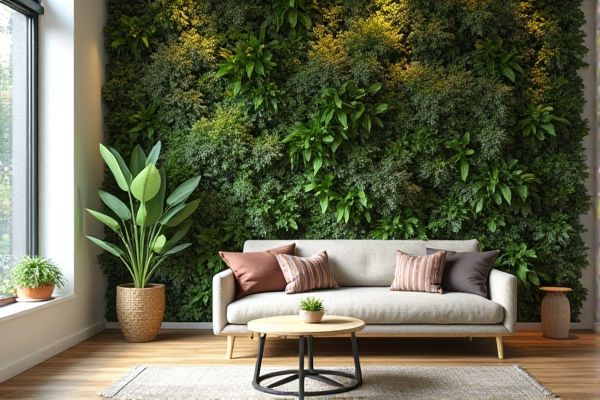
A living wall integrates a self-sustaining irrigation system and a wide variety of plants, creating a dense, vibrant ecosystem that improves air quality and insulation. Explore the full article to understand which option best suits your space and gardening goals.
Table of Comparison
| Feature | Living Wall | Vertical Planter |
|---|---|---|
| Definition | Wall-mounted system with integrated irrigation supporting dense, diverse plants. | Vertical structure for growing plants in pots or containers, less integrated systems. |
| Installation | Complex, requires professional setup and irrigation system. | Simple, often DIY-friendly with modular pots. |
| Plant Variety | Supports wide range of species, including moss, succulents, and tropical plants. | Limited to container-friendly plants. |
| Maintenance | Higher maintenance due to irrigation and plant care needs. | Lower maintenance, easier to replace individual pots. |
| Benefits | Improves air quality, insulation, soundproofing, and aesthetic appeal. | Enhances vertical green space, easy plant rotation, cost-effective. |
| Cost | Higher initial and maintenance costs. | Lower upfront cost, affordable for small spaces. |
| Space Efficiency | Maximizes greenery on vertical surfaces with dense planting. | Moderate; depends on container size and arrangement. |
| Water Management | Automated irrigation systems for consistent watering. | Manual watering; may require more frequent attention. |
Introduction to Living Walls and Vertical Planters
Living walls, also known as green walls, are vertical structures covered with a variety of plants, integrating soil or hydroponic systems for environmental benefits and aesthetic appeal. Vertical planters are modular planting systems designed for growing plants vertically without the extensive support or irrigation systems found in living walls. Both solutions maximize green space in urban environments, but living walls typically offer more complex ecosystems and air purification capabilities compared to simpler vertical planter setups.
Key Differences Between Living Walls and Vertical Planters
Living walls feature integrated irrigation systems and dense, soil-based panels that support extensive plant growth, creating a fully green facade, while vertical planters are modular containers or pockets that hold individual plants and require manual watering. Living walls often serve as architectural elements improving air quality and insulation, whereas vertical planters emphasize flexibility and ease of maintenance with customizable plant arrangements. Your choice depends on space, maintenance commitment, and the desired level of greenery impact in your environment.
Design and Aesthetic Appeal
Living walls feature integrated systems that support dense plant growth, creating lush, dynamic green surfaces that enhance indoor and outdoor spaces with a natural, immersive aesthetic. Vertical planters offer modular designs with individual pots or pockets, allowing customizable arrangements but typically presenting a less cohesive appearance compared to living walls. The choice between living walls and vertical planters depends on the desired visual impact and the complexity of the design implementation.
Installation and Setup Requirements
Living walls typically require professional installation due to complex irrigation and structural support systems, while vertical planters offer a more straightforward setup, often suitable for DIY projects. Your choice will depend on available space, wall strength, and willingness to manage integrated watering and drainage. Vertical planters are easier to install with minimal tools, whereas living walls need careful planning to ensure proper water distribution and plant health.
Plant Selection Suitability
Living walls offer a broader range of plant selection suitability, accommodating both small ground covers and larger, more diverse plant species due to their integrated irrigation and soil systems. Vertical planters are typically better suited for smaller, drought-tolerant plants or succulents, as they often rely on simpler watering methods and shallower soil depths. Your choice should depend on the specific environmental conditions and the plant varieties you wish to cultivate.
Indoor vs Outdoor Applications
Living walls excel in both indoor and outdoor applications due to integrated irrigation systems and structural support for diverse plant species, making them ideal for large-scale installations in commercial buildings and urban environments. Vertical planters, often modular and portable, suit indoor spaces better by providing flexibility and ease of maintenance for smaller areas like apartments and offices. Both systems improve air quality and aesthetic value but differ in complexity and suitability based on environmental exposure and installation scale.
Maintenance and Care Needs
Living walls require regular watering, nutrient management, and occasional pruning to maintain plant health and vibrant growth. Vertical planters generally need less frequent maintenance, with simpler watering schedules and easier access for replacing plants or soil. Your choice depends on how much time and effort you want to invest in ongoing care and upkeep.
Cost Comparison and Budget Considerations
Living walls typically involve higher costs due to integrated irrigation systems, structural support, and professional installation, making initial investment significantly greater than vertical planters. Vertical planters offer a more budget-friendly option with modular designs and simpler setups, ideal for DIY enthusiasts or those with limited funds. Your choice should weigh long-term maintenance expenses and space requirements alongside upfront costs for the best financial fit.
Environmental Benefits and Sustainability
Living walls enhance air quality by naturally filtering pollutants and reducing urban heat island effects, while vertical planters conserve space and promote biodiversity through efficient plant growth. Both systems improve insulation, lowering energy consumption, yet living walls often require more complex irrigation, making vertical planters a more water-efficient option. Sustainability is elevated through the use of native plants in either setup, fostering local ecosystems and reducing resource inputs over time.
Choosing the Best Option for Your Space
Living walls offer a continuous, soil-based system that supports a wide variety of plants, making them ideal for larger spaces requiring extensive greenery and air purification. Vertical planters provide modular, lightweight options that work well in smaller areas or for those seeking easy installation and maintenance with a focus on decorative plants or herbs. Assessing space size, plant types, maintenance level, and aesthetic goals helps determine whether a living wall or vertical planter best fits your environment.
 homyna.com
homyna.com